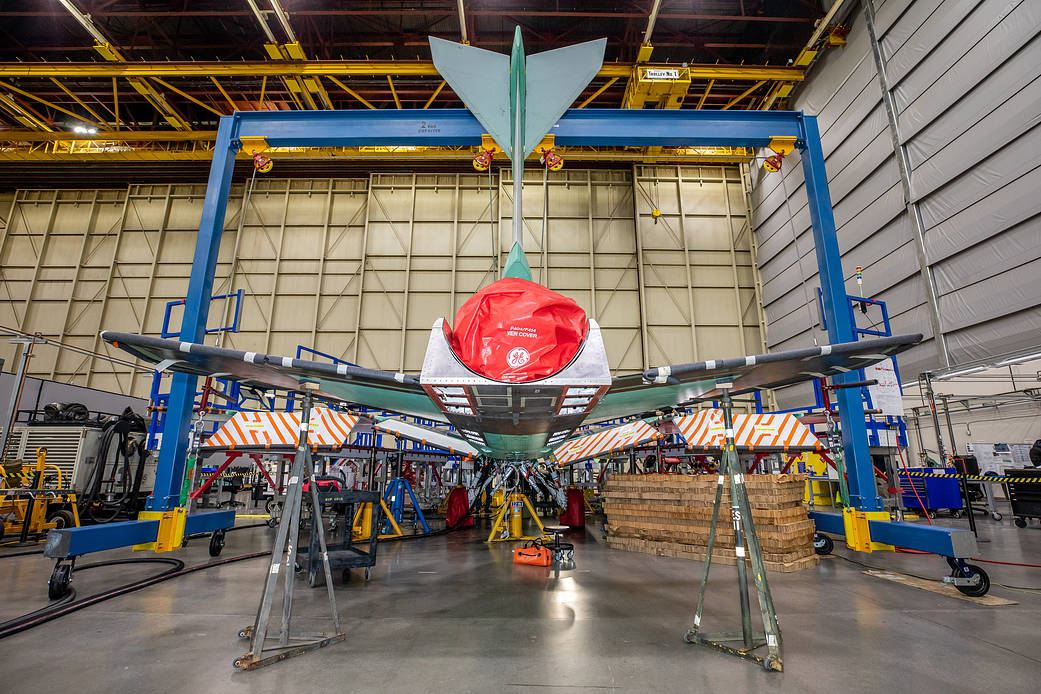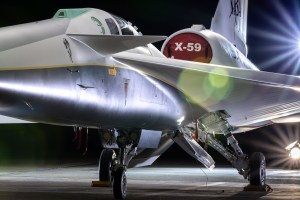1 min read
Preparations for Next Moonwalk Simulations Underway (and Underwater)  NASA’s X-59 quiet supersonic research aircraft completed its first maximum afterburner test at Lockheed Martin’s Skunk Works facility in Palmdale, California. This full-power test, during which the engine generates additional thrust, validates the additional power needed for meeting the testing conditions of the aircraft. The X-59 is the centerpiece of NASA’s Quesst mission, which aims to overcome a major barrier to supersonic flight over land by reducing the noise of sonic booms.Lockheed Martin Corporation/Garry Tice NASA completed the first maximum afterburner engine run test on its X-59 quiet supersonic research aircraft on Dec. 12. The ground test, conducted at Lockheed Martin’s Skunk Works facility in Palmdale, California, marks a significant milestone as the X-59 team progresses toward flight.
NASA’s X-59 quiet supersonic research aircraft completed its first maximum afterburner test at Lockheed Martin’s Skunk Works facility in Palmdale, California. This full-power test, during which the engine generates additional thrust, validates the additional power needed for meeting the testing conditions of the aircraft. The X-59 is the centerpiece of NASA’s Quesst mission, which aims to overcome a major barrier to supersonic flight over land by reducing the noise of sonic booms.Lockheed Martin Corporation/Garry Tice NASA completed the first maximum afterburner engine run test on its X-59 quiet supersonic research aircraft on Dec. 12. The ground test, conducted at Lockheed Martin’s Skunk Works facility in Palmdale, California, marks a significant milestone as the X-59 team progresses toward flight.
An afterburner is a component of some jet engines that generates additional thrust. Running the engine, an F414-GE-100, with afterburner will allow the X-59 to meet its supersonic speed requirements. The test demonstrated the engine’s ability to operate within temperature limits and with adequate airflow for flight. It also showed the engine’s ability to operate in sync with the aircraft’s other subsystems.
The X-59 is the centerpiece of NASA’s Quesst mission, which seeks to solve one of the major barriers to supersonic flight over land by making sonic booms quieter. The X-59’s first flight is expected to occur in 2025.
Keep Exploring Discover More Topics From NASA Armstrong Flight Research Center



 4 min read 2024: NASA Armstrong Prepares for Future Innovative Research Efforts Article 23 mins ago
4 min read 2024: NASA Armstrong Prepares for Future Innovative Research Efforts Article 23 mins ago  2 min read NASA, Notre Dame Connect Students to Inspire STEM Careers Article 5 hours ago
2 min read NASA, Notre Dame Connect Students to Inspire STEM Careers Article 5 hours ago  2 min read NASA Flight Rerouting Tool Curbs Delays, Emissions Article 5 hours ago
2 min read NASA Flight Rerouting Tool Curbs Delays, Emissions Article 5 hours ago 


